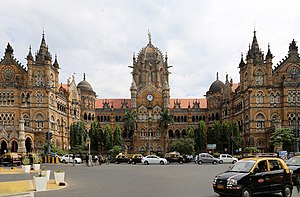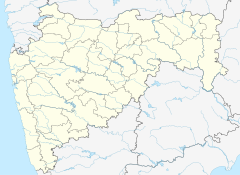
Back محطة قطار جاتراباتى شيواجى Arabic ছত্ৰপতি শিৱাজী টাৰ্মিনাছ Assamese ছত্রপতি শিবাজী মহারাজ টার্মিনাস Bengali/Bangla Estació Chhatrapati Shivaji Catalan Вокзал Чхатрапати-Шиваджи CE Nádraží čhatrapatiho Šivádžího Czech Chhatrapati Shivaji Terminus German Chhatrapati Shivaji Esperanto Estación Chhatrapati Shivaji Spanish پایانه چاتراپاتی شیواجی Persian
| Chhatrapati Shivaji Terminus | |
|---|---|
 Façade of the Chhatrapati Shivaji Terminus | |
 | |
| Former names |
|
| Alternative names | Chhatrapati Shivaji Maharaj Terminus (official) |
| General information | |
| Architectural style | Indo-Saracenic Victorian Gothic Revival |
| Address | Fort, Mumbai, Maharashtra, 400001 |
| Town or city | Mumbai, Maharashtra |
| Country | |
| Coordinates | 18°56′23″N 72°50′07″E / 18.9398°N 72.8354°E |
| Construction started | 1878 |
| Completed | May 1888[1] |
| Cost | ₹1,614,000 (US$20,000) (at the time) now ₹2,013 million (US$25 million) |
| Client | Central Railway |
| Design and construction | |
| Architect(s) | Frederick William Stevens, Axel Haig |
| Engineer | Wilson Bell |
| Website | |
| https://cr.indianrailways.gov.in/ | |
| Criteria | Cultural: ii, iv |
| Reference | 945 |
| Inscription | 2004 (28th Session) |
Chhatrapati Shivaji Terminus | |||||
|---|---|---|---|---|---|
 | |||||
| General information | |||||
| Location | Chhatrapati Shivaji Terminus Area, Fort, Mumbai, Maharashtra 400001 India | ||||
| Coordinates | 18°56′23″N 72°50′08″E / 18.9398°N 72.8355°E | ||||
| Owned by | Indian Railways | ||||
| Operated by | Central Railway zone | ||||
| Line(s) | Mumbai–Nagpur–Howrah line Mumbai–Chennai line Mumbai–Madgaon line Howrah-Prayagraj-Mumbai line Mumbai-Ahmednagar railway line via Kalyan was also in planning stage with survey of this project carried out on 1970, 2000, 2014 etc.[3] | ||||
| Platforms | 18 | ||||
| Tracks | 40 (Multiple) | ||||
| Connections | |||||
| Construction | |||||
| Structure type | At-grade | ||||
| Platform levels | 01 | ||||
| Parking | Yes | ||||
| Other information | |||||
| Status | Active | ||||
| Station code | CSMT (current) BB VT CST CSTM (former) | ||||
| Zone(s) | Central Railway zone | ||||
| Division(s) | Mumbai CR | ||||
| Website | https://cr.indianrailways.gov.in/ | ||||
| History | |||||
| Opened | May 1853[1] | ||||
| Rebuilt | May 1888[1] | ||||
| Electrified | 25 kV AC 50 Hz | ||||
| Previous names | Bori Bunder Victoria Terminus | ||||
| |||||
Chhatrapati Shivaji Terminus (officially Chhatrapati Shivaji Maharaj Terminus since 2017, formerly Victoria Terminus (VT), Bombay station code: CSMT (mainline)[4]/ST (suburban)), is a historic railway terminus and UNESCO World Heritage Site in Mumbai, Maharashtra, India.[5]
The terminus was designed by a British architectural engineer Frederick William Stevens from an initial design by Axel Haig, in an exuberant Italian Gothic style. Its construction began in 1878, in a location south of the old Bori Bunder railway station,[6] and was completed in 1887, the year marking 50 years of Queen Victoria's rule.
In March 1996, the station's name was officially changed from Victoria Terminus to "Chhatrapati Shivaji Terminus" (with station code CST) after Shivaji, the 17th-century warrior king and the first Chhatrapati of the Maratha Empire who founded the state in the western Marathi-speaking regions of the Deccan Plateau.[7][8][9]
In 2017, the station was again renamed "Chhatrapati Shivaji Maharaj Terminus" (with code CSMT), where the title Maharaj has literal meaning, "Great king; emperor."[10] Both former initials "VT" and the current, "CST", are also commonly used.[11]
The terminus is the headquarters of India's Central Railway. It is one of the busiest railway stations in India,[12] serving as a terminal for both long-distance and suburban trains with a total number of 18 platforms.
- ^ a b c d Cite error: The named reference
WHSwas invoked but never defined (see the help page). - ^ File:India Mumbai Victor Grigas 2011-15.jpg
- ^ "कल्याण-नगर रेल्वे हा विकासाचा मार्ग" [Kalyan-Nagar Railway is the path of development]. Maharashtra Times. 4 August 2017.
- ^ "Station Code Index" (PDF). Portal of Indian Railways. 2019. p. 46. Retrieved 29 June 2023.
- ^ Centre, UNESCO World Heritage. "Chhatrapati Shivaji Terminus (formerly Victoria Terminus)". UNESCO World Heritage Centre. Retrieved 30 March 2023.
- ^ Aruṇa Ṭikekara, Aroon Tikekar (2006). The cloister's pale: a biography of the University of Mumbai. Popular Prakashan. p. 357. ISBN 81-7991-293-0.Page 64
- ^ Eaton, Richard M. (25 July 2019). India in the Persianate Age: 1000-1765. Penguin Books Limited. pp. 198–. ISBN 978-0-14-196655-7. Quote: "Quote: "Amidst this fragmented political environment a new polity emerged in the Marathi-speaking western plateau. Its founder, the charismatic and politically gifted Maratha chieftain Shivaji Bhonsle (1630-80), repeatedly used courage and savvy to outmanoeuvre his adversaries."
- ^ Kedourie, Elie (2013). Nationalism in Asia and Africa. Routledge. pp. 71–. ISBN 978-1-136-27613-2. Quote: "Tilak also inaugurated another cult by resuscitating the memory of Shivaji, the chieftain who had originally established Mahratta fortunes in contest with the Mughals."
- ^ Subramaniam, Arjun (2016). India's Wars: A Military History, 1947-1971. HarperCollins Publishers India. pp. 30–. ISBN 978-93-5177-750-2. Quote: "Quote: First was the purely home-bred guerrilla force under Shivaji. The courageous and wily Maratha chieftain along with his successors and, subsequently, the Peshwas, defied the Mughals and other Muslim invaders for almost a century from the latter half of the seventeenth century and expanded the Maratha Empire till it covered much of the Indian heartland.
- ^ McGregor, Ronald Stuart (1993). "महाराज maharaj (n)". The Oxford Hindi-English Dictionary. Oxford University Press. p. 800. ISBN 978-0-19-563846-2.
- ^ "From VT to CST: Interesting facts about Mumbai's busiest railway station". Mid-day. 20 June 2017. Retrieved 1 June 2019.
- ^ "India's impressive railway stations". Rediff.com. 13 October 2011. Retrieved 4 January 2013.
© MMXXIII Rich X Search. We shall prevail. All rights reserved. Rich X Search


